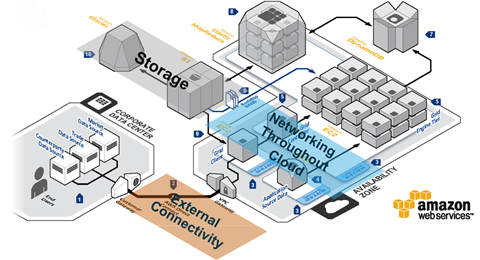Yesterday’s blog post was about the mobile market. But, increasingly, mobile is not just about handsets, but about cloud datacenters and the networking to get the data back and forth. Functions such as voice recognition or mapping depend on splitting the functionality between the smartphone, to do local processing, including encryption and compression, and the back end, where essentially infinite numbers or servers are available to do the heavy lifting before returning the results.
We can view the market as made up of several sub-segments, which consist of:
- Compute
- Wired networks (Internet)
- Wireless and access (cellular, WiFi, etc.)
- Storage
Unless you have been living under a stone for the last few years, you must know that there has been an explosion in the amount of data being moved around (especially, but not only, due to video) and in the scale of the cloud, enormous datacenters providing enormous computing capacity.
In the past, Amazon has wanted to hint at the scale of its infrastructure without being terribly specific, and so they came up with this metric. Every day, AWS installs enough server infrastructure to host the entire Amazon e-tailing business from back in 2004, when Amazon the retailer was one-tenth its current size at $7 billion in annual revenue.
And, as they reported in this interesting rare peek under the hood, they did it another 364 times. A typical AWS datacenter has 50,000 and sometimes 80,000 machines. Amazon might have as many as six million machines, along with network capacity. But that was a year ago; they have presumably added a lot more since.
Today, almost all datacenters are based on traditional Intel architecture servers. There are two interesting potential future trends. The first is the potential rise of what are known as microservers based on ARM 64-bit servers, which have much lower power, physical form-factor and cost of ownership, although without the software compatibility of Intel servers. The second is the potential for adding FPGA accelerators to servers to accelerate specific algorithms, like search or facial recognition. Indeed, it seems this is the reason Intel is acquiring Altera.
The big trend in both servers and wired networking is towards virtualization. This adds a layer between the hardware and the software (known as the hypervisor) that allows either lots of individual functions to share a single machine, or, alternatively, for a single function to be spread across dozens or even thousands of machines. In the networking world, this is called network function virtualization (NFV )and software-defined networking (SDN).
Wireless networking for cellular and WiFi, etc. actually depends on a mixture of radio interfaces (sometimes called the air interface) and wired infrastructure to connect to the Internet proper (often called backhaul, which I admit sounds more like something involving bulldozers).

In storage the biggest trend is probably the transition from rotating media to SSD (solid state disks) based on Flash memory. There are challenges in scaling this from just being in your notebook to the kind of functionality needed for large datacenters processing video and databases, mainly to the fact that Flash memory bits can only be written a limited number of times (a process known as durability, which is addressed by wear-leveling (spreading the writes around)).
There is a huge amount of IP available for the infrastructure market, ranging from memory controllers to interfaces such as Ethernet, specialized processors for LTE modems, PCIe 4 and more.








